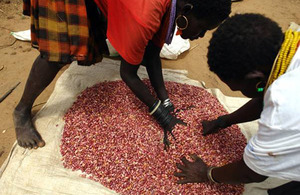Tackling hunger in Karamoja
How UK aid is helping Uganda's poorest people to grow their own food and move away from emergency handouts

Maria spreads out recently harvested beans to dry. Picture: Lydia Wamala/WFP
Food for the world’s poorest
Maria Anyuka holds up a giant pumpkin from her garden in Pupu village, before checking on the beans she has recently harvested.
Like many people who live in Karamoja, the poorest region of Uganda, Maria used to rely on emergency food aid to feed her family. Now, thanks to a project run by the World Food Programme and supported by UK aid, she grows a range of her own crops, which provide more than enough food.
“I kept the seeds of the eggplant I grew last year, and planted them this year in my backyard,” says Maria. “We ate some of the sorghum and made a local brew from the rest of it, which earned us 50,000 Ugandan Shillings.”
Maria used the money she made from her sorghum crop to send her nine year old daughter to school.
“I value education,” she says. “People often come here to write down our names. I would like my daughter to be able to write, because people get paid for writing.”
Becoming self-sufficient
Maria’s household is one of 50 in Pupu village who came together last year to grow crops through the Karamoja Productive Assets Programme (KPAP).
The programme works with communities to create local sources of income, for example by planting new varieties of crop, building irrigation systems and harnessing natural underground water sources - all of which create more reliable ways for households to grow food.
Whilst communities are working on these projects, they receive food supplies or cash to meet their short term needs.
By supporting over 75,000 households like Maria’s to grow their own food, UK aid is helping to address the causes of food insecurity in Karamoja. Together, Maria’s community now farm 50 acres of nutritious crops, so they are becoming less reliant on handouts during periods of drought.
“This year looks more promising than the last,” says Maria. “When we harvest food, we are happy.”
As a result of projects like KPAP, the number of people requiring emergency food aid in Karamoja has halved over the past year and Uganda has avoided suffering a food crisis on the scale of other countries in East Africa.
Facts and stats
Located in the north east of Uganda, Karamoja has the lowest development indicators of any region in the country. The region suffers from chronic poverty, malnutrition and food shortages, as well as frequent drought and other natural disasters
The World Food Programme began to implement the Karamoja Productive Assets Programme (KPAP) in 2010
Around 445,000 people in 75,000 households have enrolled in the programme to date
The project is a partnership between the Government of Uganda, the World Food Programme, DFID, the World Bank and nine local and international NGOs
DFID is contributing £12 million to the programme over three financial years from 2010-2013
Our funding is supporting long term community projects, such as building dams, planting new varieties of crops, building irrigation systems and harnessing natural underground water sources
World Food Programme is also using UK aid to work with communities to create local sources of income. This includes better livestock farming facilities, small irrigation schemes, improved local roads and improved seeds for the climatic conditions